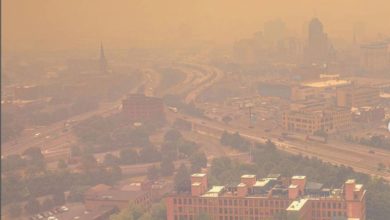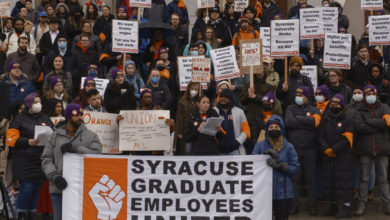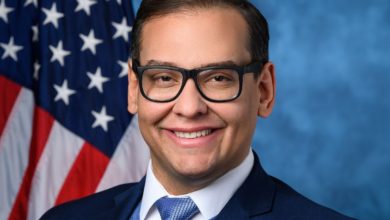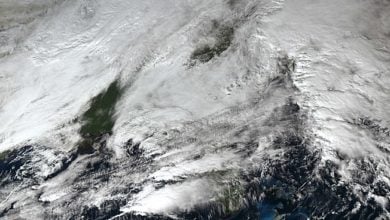Photo: Bethlehem Steel plant in Lackawanna, N.Y., near Buffalo, employing nearly 20,000 workers in 1965, closed permanently in 1983. Deindustrialization replaced hundreds of thousands of good paying jobs with low-paying service jobs in both upstate New York and New York City.
There is hardship and suffering for the working class in New York City and in upstate New York that neither community knows much about. Why is this? Do the differences among us forever doom us to division, as the corporate press would have us believe?
This article is based on a questionnaire and interviews with working-class people in both parts of the state, including Biden voters, Trump voters and socialist voters. It is only a sampling of all that we have in common.
Both major parties make promises to working-class people that they cannot keep because they are both beholden to their big financial backers.
It is clear from these comments that, despite many differences, there is a real basis for understanding and solidarity between city and country, between Black, Latino, Asian and white workers, and across barriers of sexist division.
The recent mass murder targeting Black people in Buffalo only underlines the necessity of anti-racist solidarity. Racist rants blaming Black people for unemployment takes the real culprits, corporate America, off the hook and helps no one. Anti-racist solidarity has always been the only way forward for the working class.
Frustration with the government
Michaela Kay, a community organizer in Harlem, 36, originally from the Midwest, explains: “How frustrating that the city’s local government takes advantage of its Democratic base, doesn’t relate to its constituents, and attempts to address low voter turnout without addressing the root cause.” She also criticizes the “massive budget for military spending and its negative impact on social programs.”
Michele DeVeau is a self-described DINO (Democrat in Name Only), retired, disabled with MS and a former blue collar service worker who voted for Trump. She pointed out, “There are people with fixed income, who are not getting what they need. [The politicians] don’t look at the scheme of things, like, we will do this and things will get better eventually. There are some people out there who don’t have ‘eventually.’”
Micki, 78, a life-long Republican and retired former real estate broker, grew up in Jefferson, N.Y., and now lives near Oneonta, explained: “We work hard and the Democrats have abandoned working people … So many farms have gone under upstate because they became too hard to maintain, some had been in families for over 100 years … both parties twist the truth and lie … the press can make people believe anything.”
Riecher, a trade union organizer originally from rural Alabama now working in the New York area, argued: “Most of the politicians have no idea about the people they represent, and most are millionaires. They make promises, yet once they get into office they come up with plenty of excuses, and they deepen a sense of distrust or cynicism.”
Upstate workers on differences and similarities with NYC
Chris Frigon, an Air Force veteran and licensed clinical social worker in western New York with 25 years’ experience in behavioral healthcare, explains that “a much larger multicultural population in New York City helps acceptance of multiculturalism as a result,” and upstate there is more “divisive rhetoric from elected officials that continues to incite violence with no strong counter from leaders and no real consequences for behavior.”
Riecher added: “There is a big sense of exploitation, causing distrust, of the rural by the city. There is sometimes a coastal chauvinism, that the middle of the country didn’t exist … This infuriates people living in rural areas. But differences mainly lie with the urban rich, not the urban working class. I always heard about the ‘conveniences of the city,’ but now I see that only the elite really have the conveniences … Traffic is awful, everything is expensive, safety is always a concern, rent keeps going up.”
Wendy S., a registered nurse, now retired, grew up in the Catskill Mountains and currently lives in Oregon and volunteers with homeless people: “A town in the Catskills was taken off the map to provide water for New York City. I often heard, ‘what did they do for us? All our water is going to NYC.’ There was an incredible amount of misunderstanding because there wasn’t a lot of communication going on.”
Michelle DeVeau noted, “Upstate it is harder to find decent jobs in your area. There are so many places that are so far out of reach … because there is no transportation, people don’t have money for a car, or car insurance because they can’t get a job.
She continued: “New Yorkers are just people who want to survive, whether we are in upstate or the city or Long Island, we just want to make good for our families. You know, my daughter is 33 years old, her boyfriend, her fiancé, live together in a one bedroom studio apartment, paying $800 a month. She has to drive an hour and a half to work, he has to drive an hour away … to pay the bills. They want a home, they want a family, and they can’t do it. And these are state-run jobs, both of them, but neither one of them can make enough to get ahead. It sucks. For lack of a better word, it sucks.
DeVeau concluded: “One thing to think about, in 1977, the yearly income for one person was just over $10,000. I’m on disability. I get just over $10,000. I get the same as one person working a job over 40 years ago. How am I, as a single woman, supposed to live?”
The billionaires: our common enemy
There are 105 billionaires in New York City alone and most have vastly increased their wealth during COVID. In just the first few months of the pandemic, collective U.S. billionaire wealth surged by more than $584 billion according to Forbes, while $6.5 trillion in household wealth disappeared. The Economic Policy Institute found that in 2020, “The CEO-to-worker compensation ratio rose to 351-to-1, up from 307-to-1 in 2019 and 21-to-1 in 1965.”
Every Trump voter, Biden voter, and non-voter interviewed responded to the question, “Should the billionaires be taxed more?” in much the same way:
- “Hell yeah!”
- “None are being taxed properly”
- “No such thing as an ethical billionaire”
- “Only a bullshit system would ignore the billionaires”
- “Why have so many billionaires when we don’t have enough health care”
- “They don’t pay their fair share of taxes and upstate is burdened with taxes”
- “Absolutely! Share the wealth”
Poverty, race and jobs
The rich think that poverty is something to be ashamed of, but it really just reflects the hoarding of wealth by the billionaires at the top. Here is just a sampling of official government statistics for different parts of New York. These alarming figures have only gotten worse with the COVID pandemic.
- Albany
- 32.1% of Black residents live in poverty
- 17.1% of white residents live in poverty
- 38.1% of Latino residents live in poverty
- Jamestown
- 45% of Black residents live in poverty
- 25.6% of white residents live in poverty
- 51.7% of Latino residents live in poverty
- Buffalo
- 37.4% of Black residents live in poverty
- 19% of white residents live in poverty
- 45.9% of Latino residents live in poverty
- Schohaire County
- 13.9% overall poverty (the county is 92% white)
- New York City
- 22% of Black residents live in poverty
- 12% of white residents live in poverty
- 25% of Latino residents live in poverty
- Syracuse
- 41.0% of Black residents live in poverty
- 22% of white residents live in poverty
- 45.1% of Latino residents live in poverty
- Cortland County
- 23.2% of white residents live in poverty
- 28% of people of color in the county live in poverty
These statistics make clear that there is both deep racial disparity and a growing crisis of survival in the entire working class. On top of this, the government’s official poverty line is absurdly low, minimizing the true extent of the problem.
Heather, an Arab immigrant rights attorney and community organizer in Albany, who has also lived in New York City and Washington D.C., said: “There are a lot of poor white communities in the Albany area, but much smaller compared to D.C. … I wasn’t used to that … you come up here and there are a lot of poor white areas … a lot of the issues that people have here that affect white workers are the same issues that affect Black and Brown workers on a broader scale in the large cities.”
Juan, a Latino dog groomer from Washington D.C., now living in Albany N.Y., said, “I noticed, when I worked construction sites, it wasn’t all Latino. In D.C., there aren’t too many construction workers who are Black, mostly immigrants. Here you don’t see that. Most construction jobs are white. In the kitchen, most workers in restaurants are white.
Seth from Wayne County, N.Y., explained, “As of this moment, I am technically unemployed, but am wrapping up a jobs training program. After my father turned 50, he was pushed out of that area of the workforce, and went from working jobs at high tech companies like Kodak, Lucent, DEC, Nortel, J.P. Morgan, etc., to working as a clerk at a hardware store in a small town, making around $25,000 to $30,000.”
Seth also commented on the prison system, “The overwhelming bulk of people in the Wayne County jail are not so much criminals as people with severe mental illness or peaceful drug users. This is a terrible waste of human potential and public funds.
This is a familiar story in New York City. Riker’s Island prison in New York City — with almost 30,000 prisoners, mostly Black and Latino, and almost all of whom are awaiting trial because they can’t afford bail — has been notorious for inmate abuse, beatings, sexual violence and murder.
Seth continued on the issue of housing: “Absentee landlords will often let buildings collapse because it is cheaper than maintaining them. Many of these buildings are apartment buildings. They receive very little maintenance, and consequently look terrible, and are often unsafe.”
Trump, the Democrats and the failure of all elite politicians
Michaela Kay remarked, “It’s no wonder that rural voters think Democrats are not focused on helping them. Just as people upstate are looking for alternatives in representation, to the point that they elected a wildcard like Trump in 2016, the Black community cannot relate to white liberals and feels a lack of overall representation.
John H., a musician, grew up upstate in Newburgh, N.Y., and lived in the Catskill Mountains, but now lives in New York City. He said he thought the “most frustrating thing now is how the Democratic [Party] and Republicans are at each other’s throats … I don’t think there is a real big difference other than where they live. We all want the same things for ourselves and our families. We get our asses kicked here in NYC by how expensive things are. I didn’t get my money’s worth from Trump. I was cheated by Trump, but I was not going to vote for Hillary Clinton, because of who she was and the whole Clinton legacy.”
Wendy S. said that “most of the people I work with are Republican. Big Trump fans. They love me and I love them. We have made it through our discrepancies because we have built relationships. And established respect. Trump pulled at their heart strings … he was going to get all of these things taken care of for them … and they believed him. They drank the Kool-Aid. I think that perception changed because none of those things came to fruition … Trump manipulated everyone. He was very good at that.”
She continued, “My sister’s husband’s father worked for Trump Tower for over 52 years. He started sweeping floors and then he became the head doorman and they had this big party for him, and none of the family showed up even though he was the only individual who was allowed to carry the older Trump’s bag. He showed up every day. In the end they didn’t show up. I was too young, but I heard the story.”
The saying “an injury to one is an injury to all” is the heart and soul of the trade union movement. It was never just a slogan. A united working-class movement puts upward pressure on everyone’s living standards and can build the solidarity needed to fight for respect for working class people of every nationality and end racism, gender discrimination, anti-LGBTQ bigotry, and more — and eventually can get rid of the system that lies at the root of these injustices.
But the corporate media will always define us by our differences because it makes exploitation that much easier. Their bought-and-paid-for reporters define Trump voters to Biden voters and they define Biden voters to Trump voters, laughing all the way to the bank. They leave out the very real fact that working-class people have so much in common, and how much we will benefit by mutual understanding, solidarity and struggle against discrimination.
The millionaires and billionaires try to impose a “zero sum” mindset on the working class, where every gain made by one group must always come at the expense of another. It is time to both recognize inequality and at the same time define ourselves by all that we have in common — the basis for a fight for a better world.





